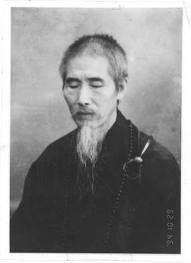In the list of ten fetters, the higher the number, the more subtle the fetter. The more subtle a fetter is, the less seriously we take it. So when we read what the sixth fetter is, we say: “Oh, that’s not so bad. I can break that fetter easily.” The sixth fetter is the desire… Continue reading Zen Practice and the Sixth Fetter
Category: The ten fetters
Zen Practice And Enlightenment
The Buddha identified four stages of enlightenment: Stream Entry (sotapanna), the Once Returner (sakadagamin), the Non-Returner (anagamin), and Buddhahood. The Buddha taught that Stream Entry is attained when the first three of the ten fetters are overcome: Those first three fetters are: 1) Belief in an independent, unchangeable/permanent or everlasting self, called atman in the Vedas, which belief… Continue reading Zen Practice And Enlightenment
Meat, Murder, Tofu And Zen
The first fold of the Eightfold Path, Right View, is sometimes translated as Right Understanding and is explained by many commentators to mean that one has Right Understanding if one understands the Four Noble Truths. But that common explanation doesn’t jive with the Buddha’s words. He said the first fold of the Eightfold Path was… Continue reading Meat, Murder, Tofu And Zen
Zen Practice And Sakkaya Ditthi
Sakkaya ditthi, the wrong view of self, is the first of the ten fetters that bind unenlightened beings. Its counterpart or antidote is Right View or Right Understanding, the first fold of the Eightfold Path. Until we arrive at samma ditthi, the correct view of self, it’s hard to loosen the other nine fetters. Who practices… Continue reading Zen Practice And Sakkaya Ditthi
Zen Practice And the Ninth Fetter
The unenlightened mind suffers from agitation. A mind that is not agitated is a mind at rest. Although there are many techniques for quieting the mind, Buddha Name Recitation works for most people. The name Amitabha or Amituo Fo has a certain charm that brings feelings of peace and quiet to those who chant it. Dharma… Continue reading Zen Practice And the Ninth Fetter
Zen Practice And The Tenth Fetter
The last and final fetter that an arahat breaks in order to realize nirvana/nibbana is the fetter of ignorance of the Four Noble Truths. Funny, but among the first things we learn of when studying Buddhism are the Four Noble Truths. Yet these truths are the last things we learn. As the last of the… Continue reading Zen Practice And The Tenth Fetter
Zen Practice And The 7th Fetter
The Pali texts define the seventh fetter as attachment to formlessness. The three worlds are: 1. The world of desire, which is the one we live in, together with hell dwellers, hungry ghosts, animals, asuras, other humans, and the gods of the world of desire; (keep in mind that these are levels of awareness, i.e., humans are… Continue reading Zen Practice And The 7th Fetter
Zen And The 4th and 5th Fetters
Sense desire is the fourth fetter and ill will or hatred is the fifth of the ten fetters. Thus we wonder why there are Five Hindrances and Ten Fetters. These fourth and fifth fetters are the same as the first two hindrances. According to the Pali canon, if we can break the first three fetters… Continue reading Zen And The 4th and 5th Fetters
Zen Practice And The Eighth Fetter
The eighth fetter, conceit, seems at first to be a lot like the first fetter, sakkaya ditthi, the wrong view of self. The eighth fetter, however, is more subtle. We may acquire the right view of self yet still feel distinctiveness, i.e., we may compare ourselves with others and find ourselves to be superior, equal,… Continue reading Zen Practice And The Eighth Fetter
Zen Practice and Sakkaya Ditthi
Spirit Rock, pictured, is a Theravada practice center. However, we use Zen in its meaning of meditation and these practitioners are sitting in meditation. This is a copy of an email I received June 14, 2010 from the Contact Us page of the old static html How To Practice Zen.com website, and my reply which I… Continue reading Zen Practice and Sakkaya Ditthi









